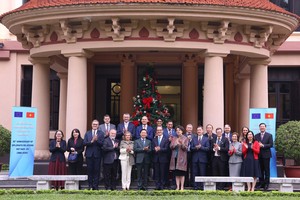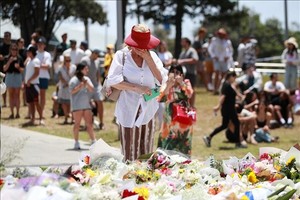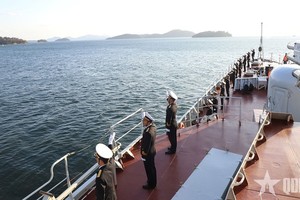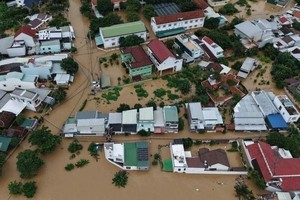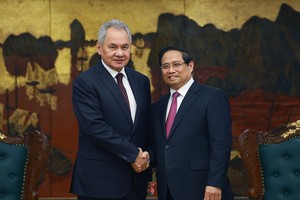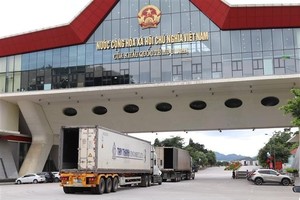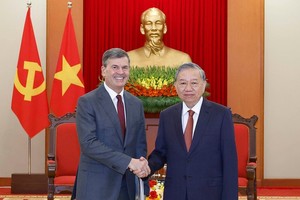Japan's radiation food scare rippled around the world Wednesday as the United States blocked imports of dairy and other produce from around a disaster-struck nuclear power plant.
Emergency crews again battled to stabilise the Fukushima Daiichi (No. 1) plant, which was shattered on March 11 by Japan's worst natural disaster in nearly a century, to prevent a full reactor meltdown.
Japan ordered the halt of consumption and shipments of a range of farm products grown near the quake- and tsunami-hit facility after health ministry tests found vastly elevated levels of iodine and caesium.
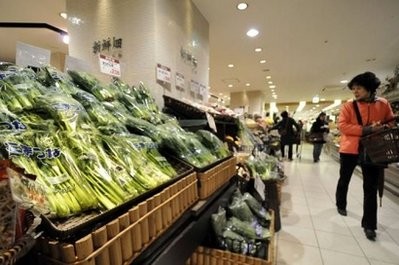
The United States restricted dairy and vegetable imports from several prefectures, and France called on the European Union to do the same, while Japan was also testing seawater to measure the impact on marine life.
Prime Minister Naoto Kan ordered a stop of shipments of untreated milk and vegetables including broccoli, cabbage and parsley from areas near the Pacific coast plant, 250 kilometres (155 miles) northeast of Tokyo.
The health ministry said radioactivity drastically exceeding legal limits had been found in 11 kinds of vegetable grown in Fukushima prefecture.
Radioactive caesium at 82,000 becquerels -- 164 times the legal limit -- was detected in one type of leaf vegetable, along with 15,000 becquerels of radioactive iodine, more than seven times the limit.
The ministry said that if people eat 100 grams (four ounces) a day of the vegetable for about 10 days, they would ingest half the amount of radiation typically received from the natural environment in a year.
Even if the short-term risk is limited for now, scientists pointing to the 1986 Chernobyl disaster warn that some radioactive particles concentrate as they travel up the food chain and stay in the environment for decades.
The US Food and Drug Administration said it had placed an import alert on all milk, dairy products, fresh vegetables and fruits from Fukushima prefecture and the nearby regions of Ibaraki, Tochigi and Gunma.
"In addition, FDA will continue to flag all entries from Japan in order to determine whether they originated from the affected area," it said. "FDA will test all food and feed shipments from the affected area."
France urged the European Commission to impose "systematic controls for all fresh produce reaching Europe's borders" from Japan, while stressing that it was not calling for a total embargo on Japanese food products "at this stage".
Around Asia, many Japanese restaurants and shops are reporting a decline in business and governments have stepped up radiation checks on the country's goods. Tainted fava beans from Japan have already cropped up in Taiwan.
Japan -- a highly industrialised and mostly mountainous island nation -- is a net food importer. According to the European Commission, the EU imported 9,000 tonnes of fruits and vegetables from Japan in 2010.
In Japan, any further food shortages threaten to compound the misery for hundreds of thousands made homeless by the 9.0-magnitude quake on March 11 and the tsunami it spawned.
The giant wave crashed into the northeast coast and nearly erased entire towns. The confirmed death toll from the disaster was nearing 10,000, and Japan holds out little hope for more than 13,000 others officially listed as missing.
As grieving survivors huddled in evacuation shelters amid the rubble of their former lives, their fate was overshadowed by the struggle to avert another massive catastrophe -- a full nuclear meltdown at Fukushima.
Fire engines and giant concrete pumps have poured thousands of tonnes of seawater onto its reactors and into spent fuel rod pools, to cool them and stop fuel from being exposed to the air and releasing large-scale radiation.
Engineers hope to restart the cooling systems of all six reactors which were knocked out by the 14-metre (46-foot) tsunami, and they have already reconnected the wider facility to the national power grid.
In their incremental progress, they partially restored power overnight to the control room of reactor three, a special focus because it contains volatile uranium-plutonium fuel rods, public broadcaster NHK reported.
As the engineers forged on with their dangerous and complex task at the 1970s-era plant, two strong quakes struck nearby, one of them with a magnitude of 6.0 -- just the latest of hundreds of nerve-jarring aftershocks.
In Vienna, the UN's International Atomic Energy Agency said it and Japan still lacked information on the state of several reactor vessels after hydrogen explosions ripped away their containment buildings.
Radiation continues to leak from the site, said James Lyons, IAEA head of nuclear installations safety.
"The question is, where exactly is it coming from: from the primary containment vessels or from the spent fuel ponds," he said. "Without the ability to go up there and actually poke around, it's hard to determine."



